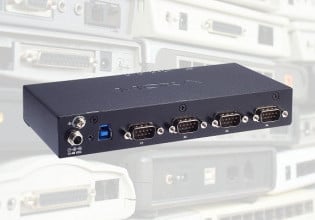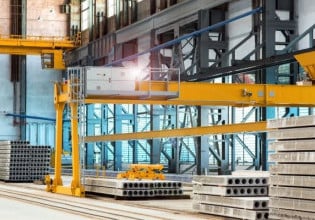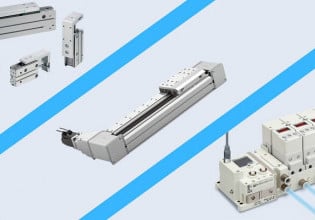What Do “Smart” Technologies Actually Include?
Technology advancements have provided us with terms that can seem foreign and confusing. Learn the definition of some of the important concepts that provide better efficiency for industrial manufacturing systems.
Smart technologies are all around us, both at home and in the workplace—including modern manufacturing, packaging, and shipping facilities. One of the benefits that smart technologies bring to the industrial setting lies in a combination of AI (artificial intelligence), IIoT (industrial internet of things), data analysis, and sustainability.

Figure 1. Smart technology, machine intelligence, machine learning, IIoT, and sustainability are more than just keywords in modern industry. Image provided courtesy of TE Connectivity
Control Automation editorial sat down with several industry leaders, TE Connectivity and MIT Machine Intelligence for Manufacturing and Operations (MIMO) to discuss smart technologies, machine intelligence, prescriptive maintenance, and more.
The Relationship Between AI, ML, and MI
Artificial intelligence (AI) is an umbrella term for the various algorithms and concepts used by systems to mimic the learning and decision-making skills of the human mind. AI includes methods such as neural networks, deep learning, and fuzzy logic.
ML (machine learning) refers more specifically to AI algorithms that allow a system to automatically learn and improve. ML can be used in various applications, from intelligent climate control to predictive and prescriptive analytics (which will be discussed in a moment).
This leads us to the definition of MI, or machine intelligence. One definition of MI is the ability of a system to perform complex tasks using various aspects of ML. It refers more to the tasks that can be accomplished by implementing ML algorithms and tools. IIoT, or Industrial Internet of Things, MI to support analytics, maintenance programs, and other tools that modern facilities use to support decision-making.
Preventive, Predictive, and Prescriptive: What’s the Difference?
John Tuley, IoT Business Development at TE Connectivity, puts the definitions of AI, MI, and ML in a more practical context: “With the advent of AI and all of the advancements in AI, machine learning algorithms take that data and do predictive and prescriptive analytics down the road. The idea is you can keep your machines running longer, you can reduce the amount of downtime, you can make things safer for your employees, et cetera.”
This means that ML and MI can help evaluate the condition of machines to support productivity and uptime.
Figure 2. Powertrains, pumps, motors, and other equipment can be better maintained, supporting both productivity and sustainability, through the implementation of smart technology. Image provided courtesy of TE Connectivity
And there are three specific maintenance paradigms that ML and MI data analytics support.
- Preventive: prevent unplanned downtime and machine failures
- Predictive: predict what is going to happen with a machine
- Prescriptive: indicate what to do in order to prevent an issue from happening
All three paradigms use AI to create a system of MI that implement ML algorithms for processing massive amounts of data and automatically learning from it.
Bruce Lawler, Managing Director at MIT MIMO, also discusses how different paradigms can work together: “Prescriptive would tell you what to do to have that thing not happen. So predictive says it's going to fail in 100 hours. Prescriptive would then say it's going to fail in 100 hours. We think your most cost-effective measure is to change it tonight. So it takes it a step farther. And machine intelligence is where the models are actually learning from the data. They're understanding the correlations within the data.”
Implementing such maintenance and analysis paradigms not only improves factors such as maintenance and operational costs, downtime, and machine failure, but also contributes to minimizing environmental impact and carbon footprint. As a very simple example, equipment that runs more efficiently reduces overall energy costs.
Machine Intelligence and Downtime
MI helps prevent unplanned downtime. Condition monitoring gathers—in real-time—a wide variety of data related to critical machines and processes. Condition monitoring essentially provides a moment-by-moment snapshot of machine health.
Condition monitoring data can include factors: important indicators of machine or process performance, such as temperature, displacement, fluid levels, pressure, power, sound, and vibration. The sensors that measure such parameters can be used (depending on the sensors) with motors, pumps, valves, bearings, or compressors.

Figure 3. Wireless accelerometers can pinpoint locations of future machine failures and prevent unplanned downtime. Image provided courtesy of TE Connectivity
And each type of data can detect several different issues: vibration data gathered from bearings can predict bearing failure, indicate issues such as misalignment, or let technicians know that there is too much or too little lubrication.
On its own, this type of real-time big data are not of much use and simply too massive to interpret. However, when fed into an MI platforms that implements self-learning ML algorithms, problematic and unusual condition patterns can be learned. Not only can they be learned and recognized, but they become even more accurate over time.
As data is delivered to the MI platform, the system can recognize the conditions of these patterns and send alerts to those responsible for the equipment and support preventive, predictive, and prescriptive maintenance—and expensive downtime and losses in productivity. As an added bonus, data for some equipment can be collected to develop effective design changes or better solutions.
Sustainability
A key area where AI, ML, and MI are impacting the industrial world is digitization and sustainability. Sustainability essentially means meeting the needs of the present without compromising the future, which ties in closely with the maintenance/analysis paradigms.
The relationship between sustainability and smart technology was recently highlighted by ABB in a report entitled “Billions of better decisions,” pointing out that IIoT solutions leveraging smart technology enable facilities to both empower their workforce and achieve sustainability goals. ABB discovered that 72% of companies are investing in IIoT solutions with the specific purpose of achieving sustainability.
Smart Technology
So how does smart technology fit into this? Smart technology processes digital data from machine sensors to inform critical decisions about maintenance and performance. As Tuley points out, smart technology makes available “more intelligence so you can make better decisions on the whole plan.”
This is reinforced in ABB’s report where 94% of respondents indicated that IIoT enables better decision-making and supports sustainability.
Figure 4. Well-designed dashboards can logically display massive amounts of data from complex automation and robotic systems. Image provided courtesy of TE Connectivity
Lawler makes it clear, however, that the analysis and intelligence provided through smart technology must be in a format that users can understand quickly, which depends heavily on application dashboards. “Dashboard data reports directly from the system with simple visualization and descriptive analytics.” This useability of data is the final ingredient in smart technology.
Conclusion
Smart technology in industrial settings starts with sensors that gather digital information on machine health and performance while MI (machine intelligence) leverages ML (machine learning) algorithms to recognize patterns and learn from the machine data in support of analytics. The analytics are then presented in a visual manner to support preventive, predictive, and prescriptive maintenance and analytics to support “billions of better decisions” related to machine health, operations, and sustainability.







So what is new? In the wood industry they have been scanning log and boards and using computers to determine how best to cut them for 40+ years.
In the late 1980s and early 1990s we made press monitors that would measure the forces on each die of a press that made beer and soda can tops ( ends ). We could tell when a bearing was going out by monitoring the standard deviation of the forces. All of the die monitor machines were connected by BNC Ethernet cables to send data back to a collection computer that could graph the data.